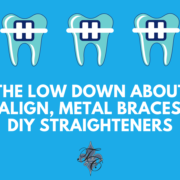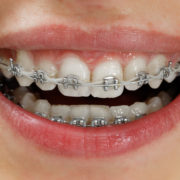Can I get braces as an adult?
Orthodontic treatment can help adults and children alike. In fact, record numbers of adults are seeking braces to straighten their smiles. According to the Dental Tribune, more than a million adults get braces each year. Fortunately, today’s patients have abundant options when it comes to braces—with many adults opting for more discreet forms of orthodontic treatment like clear and ceramic braces. If you’re looking to improve the positions of your teeth, we encourage you to speak with our Lafayette dentist, Dr. Tim Chauvin to learn more about your treatment options.
Types of Braces for Adults
Although adults can and do wear conventional orthodontia such as metal and wire fixed braces, many choose to utilize more discreet treatment methods. Less obvious orthodontic appliances can be made from materials like ceramic and clear plastic. Following is some helpful information on inconspicuous teeth-straightening methods.
Ceramic Braces
Ceramic braces are very similar to the metal and wire braces we have seen in the past. The difference, however, is that ceramic braces utilize tooth-colored brackets. When brackets are made from tooth-colored materials, they are far less obvious to others—especially in photos. These braces work the same way that conventional ones do by generating gentle but consistent pressure to move teeth to straighter, healthier positions.
Clear Braces
Unlike ceramic braces, clear braces do not utilize fixed appliances to move teeth. Instead, patients wear removable appliances. One common brand that most people know, Invisalign, consists of patients wearing removable appliances made from translucent plastics.
Many adults prefer clear braces because of their ultra-discreet appearance and because they don’t impede oral hygiene and meals. With removable braces, eating your favorite foods and performing daily oral hygiene are easy. Typically, braces constructed from smooth plastic are more comfortable than those utilizing brackets. This is because smooth oral appliances won’t irritate soft oral tissue as much as conventional braces.
Health Benefits of Braces
Orthodontic treatment can benefit more than just the appearance of your teeth; braces can improve your oral health. When our teeth are crooked, overlapped, and crowded, they tend to develop more surface debris because they are difficult to clean. Accumulation of debris like plaque and tartar greatly increases a person’s risks for developing gum disease and dental caries.
Another way that orthodontic issues contribute to dental health concerns is the fact that misaligned teeth commonly develop excessive wear. Tooth wear throws the entire oral health system off balance. When are teeth are worn down, it places strain on the temporomandibular joint (TMU) and its supportive muscles and connective tissues. This can lead to reduced oral function and orofacial discomfort. Worn teeth can drastically impact your quality of life. Treating worn teeth is also expensive as it typically involves placing custom restorations like dental crowns over affected teeth to rebuild a patient’s bite.
Preventing risks for tooth wear through orthodontic treatment is a wise investment in your dental health and can save money in the long run.
How to Find Out Which Braces Are Right for You
Learning online about your treatment options can help you determine which type of braces appeals to you. Those who value inconspicuous treatment will likely favor ceramic and clear braces over traditional metal ones whereas those who have more severe orthodontic concerns may require fixed appliances like metal braces.
Once you’ve done a little research on your options, we recommend speaking with our dentist, Dr. Chauvin. After examining your teeth, discussing your needs and goals, and reviewing your oral health history, our practice will be able to point you in the right direction. We serve patients from Lafayette and the surrounding areas. Call Tim Chauvin, DDS & Associates at (337) 234-2186 today to reserve an appointment.




